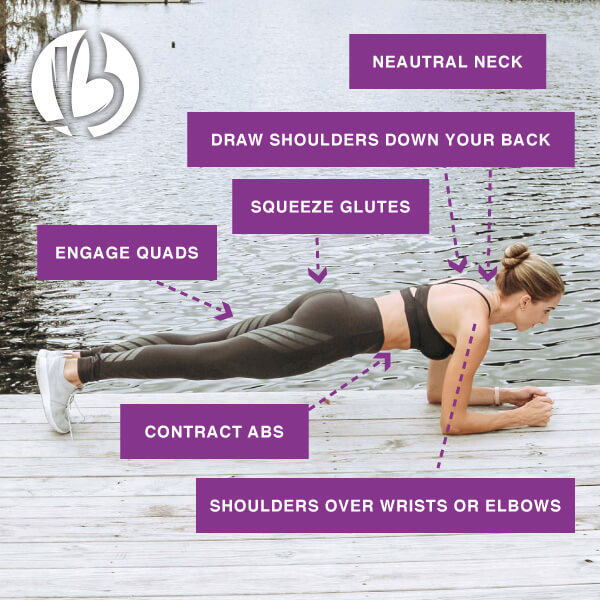How to Modify Planks
The plank is my favorite AB exercise for a flat, toned stomach because it works all the muscles in your core, including the rectus abdominis (the “six-pack muscles” you can see), transverse abdominis, internal and external obliques, hips, and back. But, there are times when you may need to modify planks and I’ve outlined when and why.
When done properly, strengthening your core through plank exercises does more than just give you a flat stomach- it also strengthens muscles that provide support for the entire body in everyday movements, reduces back pain, and improves posture.
Each year at BeyondFit, we host a 30 days of “Planksgiving” Challenge by doing a new (and super fun) plank variation everyday. (Click here to see the plank variations and form cues so you can do them too).
The most popular plank variation is the Forward Plank which involves using core muscles to keep your body maintained in a horizontal position elevated above the ground but there are many variations to the traditional Forward Plank movement.
While there are many benefits to the Forward Plank and other more difficult plank progressions, not everyone can or should be doing all plank progressions.
Studies show that some more difficult core exercises may actually force the pelvic floor downwards or create excessive intra-abdominal pressure. For women with diastasis recti or weak pelvic floor muscles, this causes issues with prolapse or pelvic floor dysfunction. If you have diastasis recti or prolapse, there are modifications that can be done depending on your core strength and degree of separation or pelvic floor weakness.
Factors to be considered when planking include:
- Current pelvic floor strength
- Diatasis recti degree of separation or core weakness
- Pelvic floor dysfunction
- Chosen type of Plank exercise
- Overall core strength
Some women with weak pelvic floor muscles will find that core and pelvic floor rehabilitation may be needed in order to progress onto more difficult plank variations.
How to Modify Planks
There are two main ways to modify the plank in order to reduce the pressure on your core pelvic floor:
1. Change Plank Position
Kneeling Plank – rather than weight bearing through the toes, modify any of the plank variations into weight bearing through your knees (kneeling Plank) so that the abdominal muscles don’t need to work as hard to hold the body above the ground. You can also lower your toes to further reduce the load on your pelvic floor
2. Decrease Plank Duration
The longer the body is held above the ground during the plank exercise, the longer the pressure on the pelvic floor is maintained. If you are completing a pelvic floor strengthening program you may find that as your pelvic floor becomes stronger you are able to maintain the plank for longer without impacting upon your pelvic floor. If you know your pelvic floor is weak, avoid maintaining Plank positions for extended periods of time.
Plank Tips: Breathe Normally
Try to breathe normally throughout The Plank and avoid holding your breath. Holding your breath during maintained exercises such as The Plank will increase your blood pressure as well as the pressure on your pelvic floor. Make a practice of breathing normally during exercises that require maintained positions and try to breathe out with the effort of strength exercises.
Practice Proper Form
Proper plank form involves much more than simply resting on your elbows and toes. Before you modify Be sure that you’re engaging your core in order to hold the plank progression.

Don’t:
- Sag your hips toward the floor.
- Push your butt in the air.
- Drop your head toward the floor.
Do:
- Keep your spine in a straight line from head to toe.
- Engage your glutes.
- Tighten your abs.
- Keep your elbows directly beneath your shoulders.
- Keep your shoulder blades back and down.
Tips for Correct Plank Technique
- Commence Plank using the modified kneeling technique described above
- Tucked your elbows close to your body
- Keep your shoulder blades back and down
- Keep your spine straight and your chin slightly tucked
- Avoid dropping your hips
- Breath normally throughout
- Progress to full Plank position only if you are confident in your technique and pelvic floor functioning
When to Modify a Plank
If at any point through your plank you notice signs of core and pelvic floor weakness, please move to a modification until the entire plank hold can completed without any of the following:
- If you are straining from within your abdomen or pelvic floor during the exercise
- If you leak urine when doing any of the exercises
- If you notice pelvic or lower back pain during or after the exercise
- If you feel unstable in the core during the exercise
- If there is bulging or “coning” in your abdomen during the exercise
P.S. Did you know that many core exercises do more harm than good? Most common “Ab” Exercises to avoid until you’ve Reconnected, Retrained, and Rebuilt your core:
- Crunches
- Sit-ups
- Oblique Twists
- Double Leg Lifts
- Pilates Roll-Ups
- Jacknifes
- Pilates 100s

Want to learn more? Click here to take our Mom Tummy Rehab Course!
- 5 Exercises 5 Minutes 5 Days
- Each workout contains 5 exercises.
- Each workout lasts 5 minutes.
- Each workout should be done 5 days/week.
Mom Tummy Rehab is a 12 week program designed for moms in any stage, to get rid of their Mom Tummy! The program includes …
- 3 phases of workouts designed to heal and rebuild your abdominal muscles
- Printable workouts with demo videos
- Accountability with other moms and direct contact with your coach Kate Horney
- TONS of bonuses and so much more!